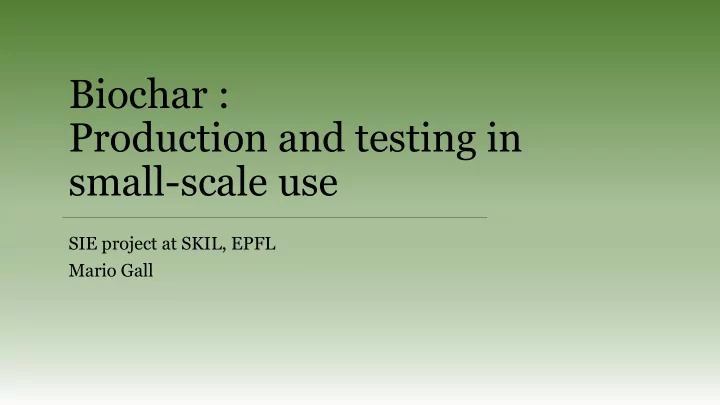

Biochar : Production and testing in small-scale use SIE project at SKIL, EPFL Mario Gall
Project overview › Produce biochar in a simple way ▫ Stove construction ▫ Pyrolysis of organic waste and wood › Test the fertilization capacity of biochar ▫ Growth of Spinach and Radish ▫ Comparison to compost fertilization and no fertilization ▫ Production of a timelapse video of the radish growth 2
What is biochar? “The solid product of thermal decomposition of organic matter at a temperature below 900° C under conditions of oxygen deficit” ( Godlewska et al. 2017) = a stable form of organic matter ▫ Rich in nutrients ▫ Slowly degradable ▫ Porous with a large surface area 3
What is biochar? “The solid product of thermal decomposition of organic matter at a Difference to fresh organic matter temperature below 900° C under conditions of oxygen deficit” › Long-term fertilizing effect ( Godlewska et al. 2017) ▫ Reduced risk of leaching into the groundwater = a stable form of organic matter ▫ No “fertilization peak” at the moment of application, but rather a constant ▫ Rich in nutrients effect ▫ Slowly degradable › Improved soil properties ▫ Porous with a large surface area ▫ Better water retention ▫ Increased ion exchange ▫ Favorable structure for microorganisms 4
What is biochar? “The solid product of thermal decomposition of organic matter at a temperature below 900° C under conditions of oxygen deficit” ( Godlewska et al. 2017) Difference to compost › Long-term fertilizing effect = a stable form of organic matter ▫ Nutrient-stabilizing matrix ▫ Rich in nutrients (even more than in compost) ▫ Slowly degradable › Improved soil properties ▫ Porous with a large surface area ▫ Better water retention ▫ Increased ion exchange ▫ Favorable structure for microorganisms 5
Why do we need biochar? ( Godlewska et al. 2017) 6
Part I: Stove construction Concept: «Dome school biochar stove» Original – 1.4L Upscaled version – 200L My version – 20L (Kelpie Wilson 2010) (Kristen Brandley 2013) 7
Stove construction Lid with a central hole: Balance between air flow and heat retention Inner can aeration: Escape pathway for pyrolysis gases Zone of wood burning Zone of biomass pyrolysis Bottom aeration: Perforated inner can, large holes in outer can 8
Stove performance › Simple construction › Easy to use › It works › Can also be used as a grill › Low temperature › Too much oxygen → Incomplete and heterogeneous pyrolysis → Big fuel (wood) requirement 9
Part II: Vegetable cultivation Comparative approach: Biochar vs. Compost vs. Control ▫ Cultivate radish and spinach (spring crop) ▫ Same growth conditions (light, irrigation, pot size, sowing, …) 10
Growth analysis Initial idea ▫ Leaf fluorescence ▫ Porous exchange ▫ Soil moisture ▫ Soil ion exchange capacity ▫ Harvest comparison 11
Growth analysis Initial idea ▫ Leaf fluorescence ▫ Porous exchange ▫ Soil moisture ▫ Soil ion exchange capacity ▫ Harvest comparison 12
Growth analysis Adapted approach ▫ Harvest comparison ▫ Timelapse video of growth → Focus only on productivity improvement! 13
Results 14
Results Sowing: March 4 March 21 March 30 Control Biochar Compost 15
Results April 11 April 17 (harvest) Control Biochar Compost 16
Results 17
Result discussion › Radish: Same result for compost and biochar ▫ Cultivation for 44 days ▫ Control leads to much smaller radish › Spinach: Victory for the compost! ▫ Cultivation for 61 days ▫ Biochar improves growth, but not as much as compost Biochar addition results in considerable improvement of → soil fertility without being the outstanding solution. 18
Result discussion: Improvements › Low significance ▫ No replicates (logistics) ▫ No measurements during the growth phase › Neglect of other aspects of biochar addition ▫ Productivity improvement is only one aspect ▫ Soil improvement? ▫ Sustainable cultivation? ▫ Environmental impact? ▫ … 19
Conclusion › Produce biochar in a simple way › Stove: Works, but not optimal ▫ Stove construction ▫ Low temperature, too much O2 ▫ Pyrolysis of organic waste and wood ▫ High fuel consumption → Space for improvement, but good › Test the fertilization capacity of as a first solution biochar › Biochar: Good fertilizer ▫ Growth of Spinach and Radish ▫ Very interesting topic ▫ Comparison to compost fertilization and no fertilization ▫ More research required ▫ Production of a timelapse video ▫ Long-term effects to be studied of the radish growth 20
Conclusion – future scope › Pots will hopefully remain available ▫ Interest from Campus durable ▫ Storage at “ Ferme de Bassenges ”? › Many possible topics to be studied ▫ Cultivation of other crops, during other cropping seasons ▫ Long-term effect: same experiment every year ▫ Soil analysis: Nutrient depletion, water retention, … ▫ Effect of different biochar loads ▫ … 21
Thanks for listening! I hope you liked it as much as I did Questions? 22
Recommend
More recommend